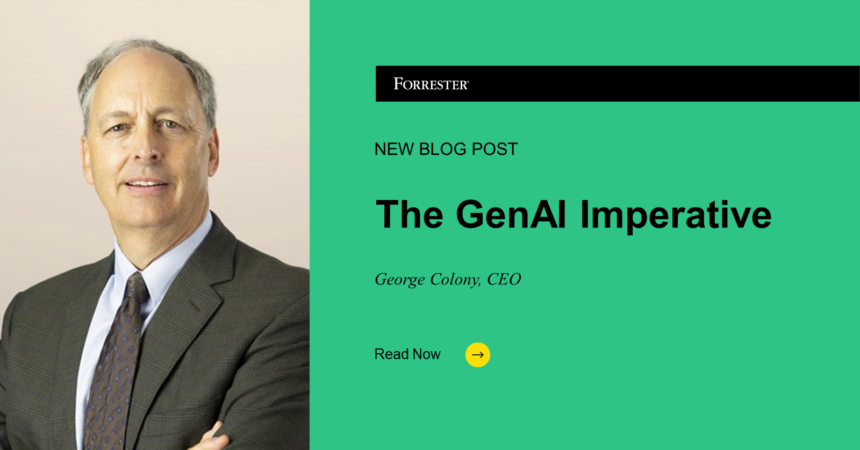In Forrester’s 40 years, we’ve rarely recommended that clients move immediately to build a new technology. We typically counsel cautious experimentation until the tech matures and the vendor landscape rationalizes.
We’re breaking that rule with generative artificial intelligence (genAI). We believe that you must move NOW.
This isn’t crypto and it’s not blockchain and it’s not the metaverse. Crypto was for speculators; blockchain was for programmers; the metaverse was for gamers. This is the biggest technology/business change of my lifetime, and if you’re in your 40s, it will be one of the two or three biggest of your lifetimes. This change will cause extinction for many, but opportunity and growth for many more. Position yourself not to be a victim. Position yourself to win.
Why now?
For my entire career, going back to 1979, I’ve been told that artificial intelligence is “the next big thing” and that “next year, it’s going to arrive and change everything.” It wasn’t, and it never did.
In the tech industry, big shifts are hard to predict. The ingredients may be visible, but foreseeing when they’ll combine to create something new is close to impossible. Years ago, Forrester noted that tech change happens abruptly, suddenly, and seemingly out of the blue — like a thunderstorm arriving on a summer day. You’re outside in the sun in the morning, go in for lunch, and come out to lightning and rain. Tech thunderstorms sneak up and arrive with a surprise.
What triggers these tech thunderstorms? They’re typically ignited by a fundamental change in user interface. The PC thunderstorm was triggered in 1982 by MS-DOS — the first easy-to-use and accessible personal computer operating system. In 1994, the Netscape browser suddenly ushered in the World Wide Web. Steve Jobs’ app home screen, the heart of the iPhone, kicked open the smartphone door in 2007.
The user interface change that ushered in generative AI was OpenAI’s ChatGPT prompt, which became available in November 2022, fully five years after researchers defined the technology. This simple and easy way to query a large language model has galvanized users. Theory flipped to reality, and the thunderstorm arrived. If you haven’t tried it, go here.
What is this thing?
Here’s my simple definition: Generative AI enables human beings to converse in their own language with big piles of data and to create new content from that data.
I have a life insurance policy, and every few years, my broker sends me the policy to review. I dread that moment because I don’t really understand insurance — I find it opaque and boring. But what if I could converse with my policy?
“How much have I paid into the policy?”
“$275,000.”
“If I died today, how much would the beneficiaries get?”
“$350,000.”
“If I cashed in the policy today, how much money would I get?”
“$325,000.”
“Can I change the beneficiaries?”
“Yes, you can. Do you want to do that right now?”
“Yes, change the beneficiary from A to B.”
“OK, we’ve made that change. Do you want me to send you the revised policy?”
“Yes, that would be great.”
The world is full of big piles of data that humans don’t understand or don’t want to read or don’t have time to read. With genAI, they can converse with that data and get what they need, when they need it, in a form that’s customized for them. This is a very, very big deal that will radically change how knowledge is built, distributed, and consumed.
Impact One: No More Web As We Know It
There’s no bigger big pile of data than the web. For 30 years, we’ve spent our lives sifting through that pile looking for answers. The web has always been a simplistic mess, full of poorly designed pages, confusing sites, non sequitur graphics, and buried data. But it’s all we’ve had, so we’ve used it for 30 years.
Generative AI will replace much of the web. Instead of going to Bank of America’s website and searching for balances, credit card transactions, or mortgage payments due, you’ll go to your bank’s big fat prompt box and start conversing. Behind that prompt will be your bank’s “content” — a continually updated generative large language model that will answer your questions and dynamically build graphics and charts to help you understand what your money has been up to. The result will be faster service, on-the-fly customization, improved experience, and more informed and satisfied customers.
What will this new world look like? You’ll type in www.taylorswift.com and go to the site. That won’t change. But what you’ll find there will be very different from the old web. Yes, there will some artistic pictures of the latest tour. But the primary experience will happen through the “Talk to Taylor” prompt box, where fans can buy tickets, buy merchandise, find out about tour dates, and get the latest videos, all through a conversation. And fans will talk to the “Taylor Language Model.” These personal conversations with “Taylor” will be driven by a model trained on the artist’s lyrics, interviews, statements, diaries, and proprietary content.
The era of searching for data is in its twilight. The era of conversing with data is dawning. Yes, the web will still be around (many people will still want to search and read). But it will be overshadowed by the more convenient and faster genAI experience.
Impact Two: The Death Of Google
With the decline of the web, the bell has rung for Google. Why are we all on a treadmill of searching the web, being given a bunch of websites, and then reading through those websites hoping to find the answer? Because every time you search and look at a website, Google gets paid. The company desperately wants us on this treadmill because 80% of its revenue derives from selling Google Ads.
But generative AI will get us off.
I recently boarded an American Airlines flight from Boston to Dallas, connecting to Austin. We were all strapped in when the pilot announced that four tires on our plane had to be changed (after millions of miles of flying, that was a new one for me). I panicked because I had to be in Austin that day. I quickly pinged ChatGPT with this question: “How long does it take to change a tire on the Airbus 319?” And I instantly got this answer: “Approximately 30 minutes.” So I did the math: 4×30 minutes equals two hours which meant that I was not going to make my connection. I quickly booked the last seat to Dallas on another carrier. Five minutes later, the pilot came over the intercom and said, “It’s going to take about two hours to change the tires.” I had been saved by generative AI. In contrast, if I had googled my question, I would have been dumped into a pile of websites that I would have had to wade through and decipher. Would I have ended up wildly scrambling through the 500-page A-319 repair manual? Probably.
Generative AI will end the maddening game of searching through the web for pages that may or may not give us answers. We’ll get answers faster while bypassing Google and Bing. What will become of the ad word model? A new advertising paradigm will undoubtedly emerge — woven into the AI conversation.
Impact Three: Trust As A Business Weapon
Will customers trust generative AI? Not if it’s generating what Forrester calls “coherent nonsense.” If companies unleash unfiltered and inaccurate generative AI content on unsuspecting customers, they’ll end up losing share, brand currency, and buyers.
Which means that people are still in the picture. As companies operate generative AI, they’ll have to continually monitor and perfect to ensure that it’s imparting valuable information, not hallucinations. In that respect, this is an “Iron Man” moment, not a robot moment — it’s an opportunity to put workers in “suits” of technology to enable them to serve customers better. As long as the customer knows that a human being is in that suit, trust will advance, because people trust people.
And that will happen as employees are relieved of doing repetitive work (like answering the same question over and over), freeing them up to devote higher-quality time to their customers. I’m going to coin a new term here: “Human AI,” which combines the quality and speed of digital with just the right sprinkling of human connection and intimacy.
There will be fewer human touch points, but they will become critical moments of truth.
Conclusion
The time is now. Companies and leadership teams can’t wait. The opportunity is too important, and the learning curves are too steep to ignore — get on them immediately. Begin the process of converting your big piles of data into models that your customers can converse with.
We’re advocating that companies appoint one executive team member to be the lead for artificial intelligence. The early going will be quite technical, so we’re advising that the CIO or the chief digital officer should run point. And because much of the generative AI content will be used to improve customer experience, the CMO should be a close partner to the lead executive.
Welcome to what Ted Schadler at Forrester calls “The Intelligent Century.” Here are links to Forrester content that can give you more basics (including précis if you’re not a client):








